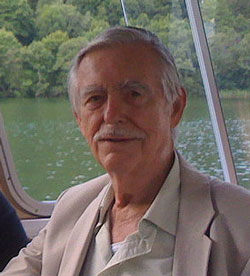Big-bang-defying giant of astronomy passes away

Halton Arp passed away on Saturday morning 28th December 2013 in Munich, Germany. He will be sorely missed by many but not so much by others because of his challenges to the ruling big bang paradigm.
With Geoffrey Burbidge and others, Professor Halton Arp was a thorn in the side of those who held to the standard story line of the big bang. In many papers and several books1 he promoted the idea that quasars are born from the nucleus of active galaxies—parent galaxies.
In the standard big bang model their very large redshifts are interpreted according to the Hubble Law to mean they are the most distant sources in the universe.
According to Arp’s alternative model, evidence strongly suggests that they are associated with relatively nearby active galaxies and that they have been ejected from those parent galaxies.

One extremely good example of this was reported in the Astrophysical Journal2 in 2004 where a quasar was found embedded in the galaxy NGC 7319 only 8 arc minutes from its centre. See figure 1. The arrow indicates the quasar.
This finding was presented by Margaret Burbidge at the January 2004 AAS meeting in Atlanta. The response, according to Halton Arp, was “overwhelming silence.” It was reported on the University of California, San Diego webpage (10 January 2005).3 The subtitle is “Can A ‘Distant’ Quasar Lie Within A Nearby Galaxy?”, extolling the riddle.
According to the Hubble law the galaxy NGC 7319, with a redshift of 0.022, is at a distance of about 360 million light-years. Assuming the Hubble Law holds for larger redshifts, the quasar, with a redshift one hundred times larger, must be about thirty times farther away, according to the dominant prevailing belief. Therefore these objects could not be physically connected to each other if this was true.
However, Arp has shown1 that there is a very strong case that quasars that lie close to active galaxies, on the sky, are, in fact, physically associated with those galaxies. That is, the closeness is not just a trick of the line of sight, where the quasars are millions or billions of light-years behind the galaxy and merely happen to be almost directly behind it from our point of view.
Arp (and others) have gone on to contend that the quasars have been ejected from the hearts of their parent galaxies.4 In 2012 Fulton and Arp in a study of tens of thousands of galaxies and quasars tested for the physical association of candidate companion quasars with putative parent galaxies and found an extremely high statistical correlation (> 50 sigma) when the ejection hypothesis and Karlsson periodicity in quasar redshifts are included.5

In the case of the galaxy NGC 7319 the quasar is not accidentally aligned due to a projection effect because it is seen interacting with gaseous material in the host galaxy. A very strong outflow of gas is detected consistent with the ejection of the quasar entraining material with it. And the outflow is projected out towards the observer. See figure 2.
The ejection-of-quasars-from-galaxies interpretation is vigorously rejected by the big bang community. Obviously this is because it utterly demolishes their key assumption of the genesis of all matter at the big bang. Also it calls into question many redshift-distances determined by quasar redshifts.
In the section ‘Alternatives to the big bang’ on page 393 of his book,6 Professor Joseph Silk admits,
“Only by disputing the interpretation of quasar redshifts as a cosmological distance indicator can this conclusion be avoided” [my emphasis added].
Silk means that if quasar redshifts do mean that they are reliable as distance indicators then the origin of all matter was in the big bang. Arp disputes this, and, in fact, it is the main thrust of Arp’s observations! They cast enormous doubt on the distribution of galaxies in the universe and the interpretation of big bang expansion models.7
References
- Arp, H. Seeing red, redshifts, cosmology and academic science, Apeiron, Montreal, 1998; Arp, H. Quasars, redshifts and controversies, Interstellar Media, Cambridge University Press, Berkeley, California, 1987; Arp, H. Companion galaxies: a test of the assumption that velocities can be inferred from redshift, Ap J 430:74–82, 1994; Arp, H. The distribution of high-redshift (z>2) quasars near active galaxies, Ap J 525:594–602, 1999; Arp, H. Catalogue of discordant Redshift Associations, Aperion, Montreal, 2003. Return to text.
- P. Galianni, E. M. Burbidge, H. Arp, V. Junkkarinen, G. Burbidge, Stefano Zibetti, The discovery of a high redshift X-ray emitting QSO very close to the nucleus of NGC 7319, Ap. J. 620(1):88-94, 2004; preprint at arxiv.org/abs/astro-ph/0409215, v1, 9 Sep 2004. Return to text.
- ucsdnews.ucsd.edu/newsrel/science/mcquasar.asp. Return to text.
- Hartnett, J.G. Quantized quasar redshifts in a creationist cosmology, J. of Creation, 18(2):105– 113, 2004. Return to text.
- C.C. Fulton and H.C. Arp, The 2dF redshift survey. I. Physical association and periodicity in quasar families, Ap J 754:134-143, 2012. Return to text.
- Silk, J., The Big Bang, W.H. Freeman and Co., New York, 2000. Return to text.
- Hartnett, J.G. The heavens declare a different story! J. of Creation, 17(2):94– 97, 2003. Return to text.



Readers’ comments
Comments are automatically closed 14 days after publication.